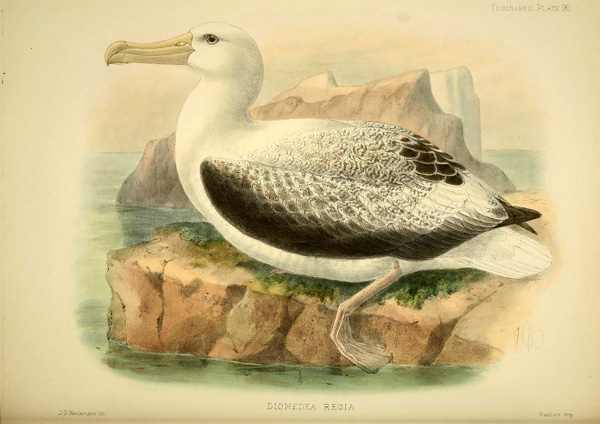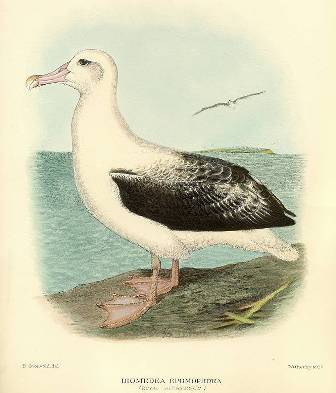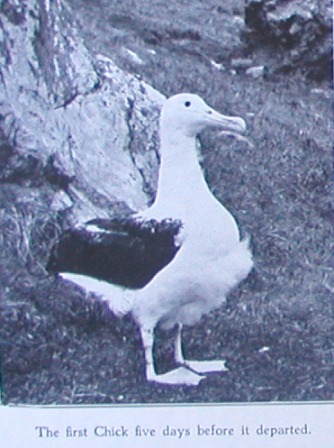


Royal albatross, Toroa, (DIOMEDEA REGIA), Godman
T he larger Southern royal albatross, epomorphora, breeds on the Auckland and Campbell Islands; the smaller Northern royal albatross, sanfordi, breeds at the Chatham Islands and at Taroa Head, near Dunedin. The two forms have interbred at Tairoa Head.
L.E. Richdale writes in 1942; “Frequenting lonely places, remote from the haunts of man, the royal albatross has in the past preserved a degree of privacy with regard to the intimate details of its existence which is enjoyed by few other large sea birds. Its isolation has hitherto screened it alike from the casual gaze of the merely curious and the more searching scrutiny of the scientific observer. Consequently the literature dealing with the bird is somewhat meagre, but the hatching of a chick on February 3, 1938, at Tairoa Head made it possible, for the first time, to discover some of the hidden details of its life history.
“The royal albatross may have nested at Tairoa Head, which is situated at the most northerly tip of the Otago Peninsular, overlooking the entrance to the harbour, about one hundred years ago, but I can find no direct evidence. Fishermen off the coast have recorded the presence of the birds on many occasions, and when Sir Walter Buller set up his new species in 1891 he exhibited thirteen specimems which had been taken by fishermen of the coast near Port Chalmers.
“Early in the history of New Zealand the Head was occupied by signalmen and lighthouse keepers, who were soon to witness the fortification of the promontory, with the consequent arrival of a number of soldiers and many prisoners. From 1899 to 1911 a relative of mine was in charge of the area, and members of his family assure me that the grass on the present nesting grounds was kept closely cut, and that the paths on which several nests have been built were kept free of weeds. During that period about one hundred people, including thirty children, were resident there, and it can be readily understood that under these conditions it was impossible for a bird to have nested unnoticed.
“There is evidence, however, that between 1914 and 1918 birds began to land on the area, as many as six having been seen at one time. Early in 1919 the Head was deserted by all except three signalmen and their families, a circumstance that was distinctly favourable for the albatross to gain a footing. Towards the end of that year the first egg is reported to have appeared; it was alleged to have been fried and eaten by a local resident. Next year, in November, 1920, it is known for certain that an egg appeared, for it was taken by one of the signalmen, and is now in the Otago Museum along with a similar egg taken in 1923. Since then there is evidence that at least one egg was laid each season.
“In 1935, for some strange reason, nobody wanted the egg, and it was allowed to hatch on February 1, 1936. About ten weeks later the chick was killed, alledgedly by a stoat, but more likely by some visitor’s dog. The appearance of a photograph in the Otago Daily Times of one of the incubating birds that season was the first intimation I had that something of immense value to science existed at our own front door. It must be remembered that very little was known, at that time, about this large sea bird. It seems incredible, too, that for so many years the existence of this treasure remained unnoticed by any ornithologist.
“In November, 1936, I saw the albatross for the first time, when it was sitting on an egg, which was subsequently stolen. By the 1937–38 season, however, The Royal Society of New Zealand, Otago Branch, took steps to afford the birds some measure of protection, and this resulted in the hatching and successful rearing of the first chick. In addition, I spent all my weekends and holidays guarding and studying the little creature.”


Toroa, royal albatross, Mathews

Toroa, Royal albatross, Richdale
| Taxonomy | |
|---|---|
| Kingdom: | Animalia |
| Phylum: | Chordata |
| Class: | Aves |
| Order: | Procellariiformes |
| Family: | Diomedeidae |
| Genera: | Diomedea |
| Species: | epomorphora |
| Sub Species: | epomorphora, sanfordi |
Southern royal albatross, Northern royal albatross
Endemic bird
115 cm., 9 kg., wingspan 3 metres plus. Its appearance is like the palest adult wandering albatross with a white body, black wings and white tail, but the bill has a black cutting edge to the upper mandible.
epomorphora, breeds on the Auckland and Campbell Islands; sanfordi, breeds at the Chatham Islands and at Tairoa Head, near Dunedin.
Souvent, pour s’amuser, les hommes d’équipage
Prennent des albatros, vastes oiseaux des mers,
Qui suivent, indolents compagnons de voyage,
Le navire glissant sur les gouffres amers.
À peine les ont-ils déposés sur les planches,
Que ces rois de l’azur, maladroits et honteux,
Laissent piteusement leurs grandes ailes blanches
Comme des avirons traîner à côté d’eux.
Ce voyageur ailé, comme il est gauche et veule!
Lui, naguère si beau, qu’il est comique et laid!
L’un agace son bec avec un brûle-gueule,
L’autre mime, en boitant, l’infirme qui volait!
Le Poète est semblable au prince des nuées
Qui hante la tempête et se rit de l’archer;
Exilé sur le sol au milieu des huées,
Ses ailes de géant l’empêchent de marcher.
— Charles Baudelaire
Richdale, L.E., The Royal Albatross, 1942.
Godman, Frederick du Cane, Monograph of the Petrels, 1907-1910.
Mathews, G.M., Birds of Australia, 1910-27.
Richdale, L.E., The Royal Albatross, 1942.
Heather, B., & Robertson, H., Field Guide to the Birds of New Zealand, 2000.
Royal albatross colony (at Tairoa Head)
Thursday, 3 August, 2023; ver2023v1